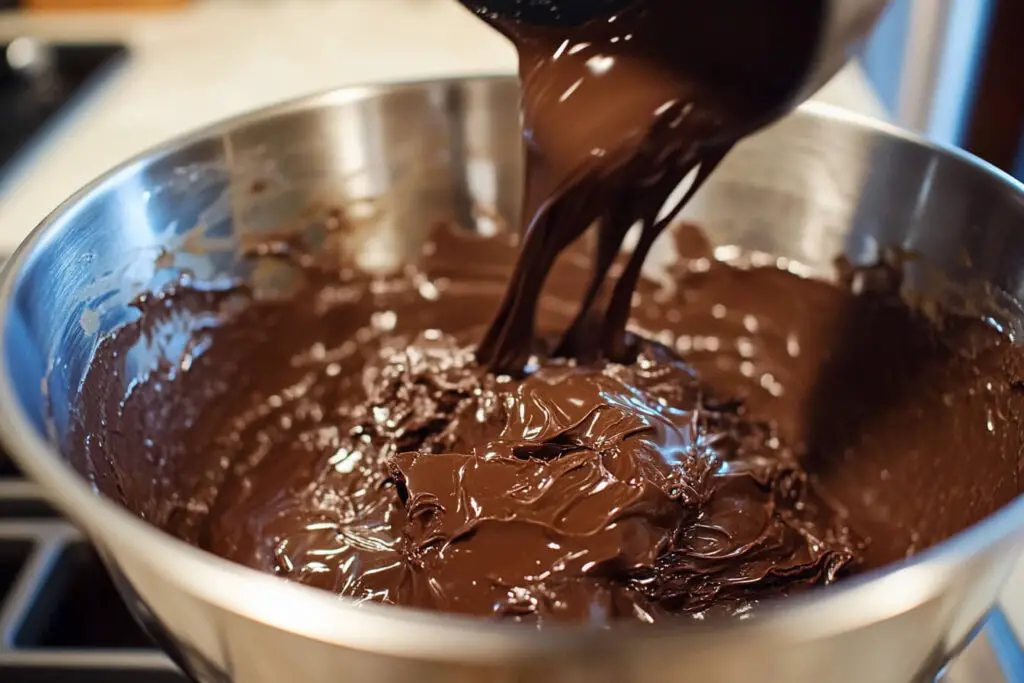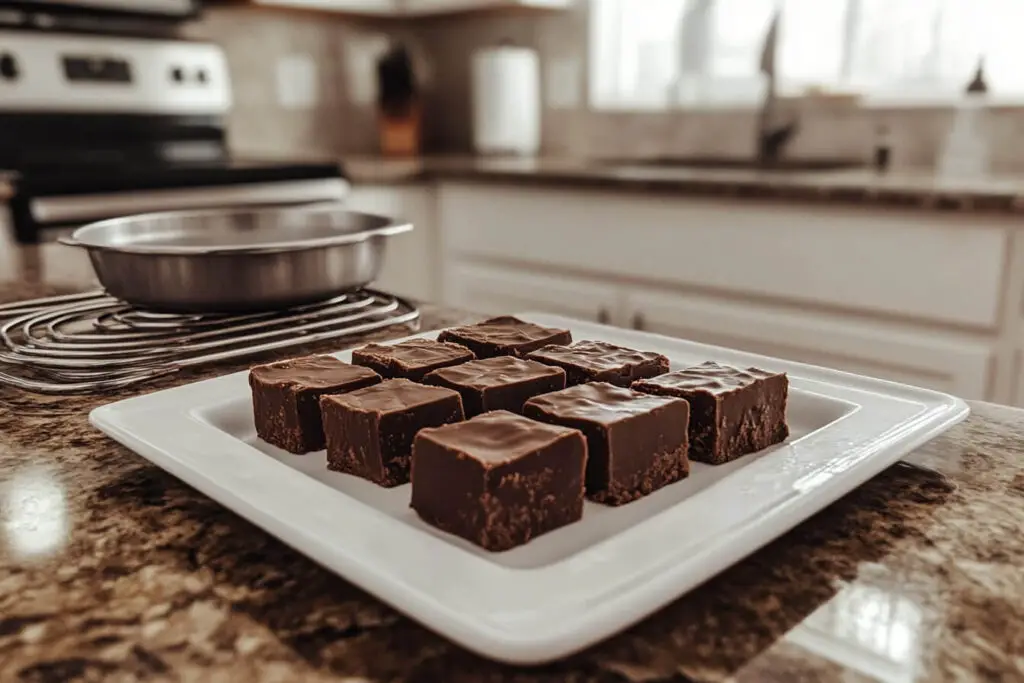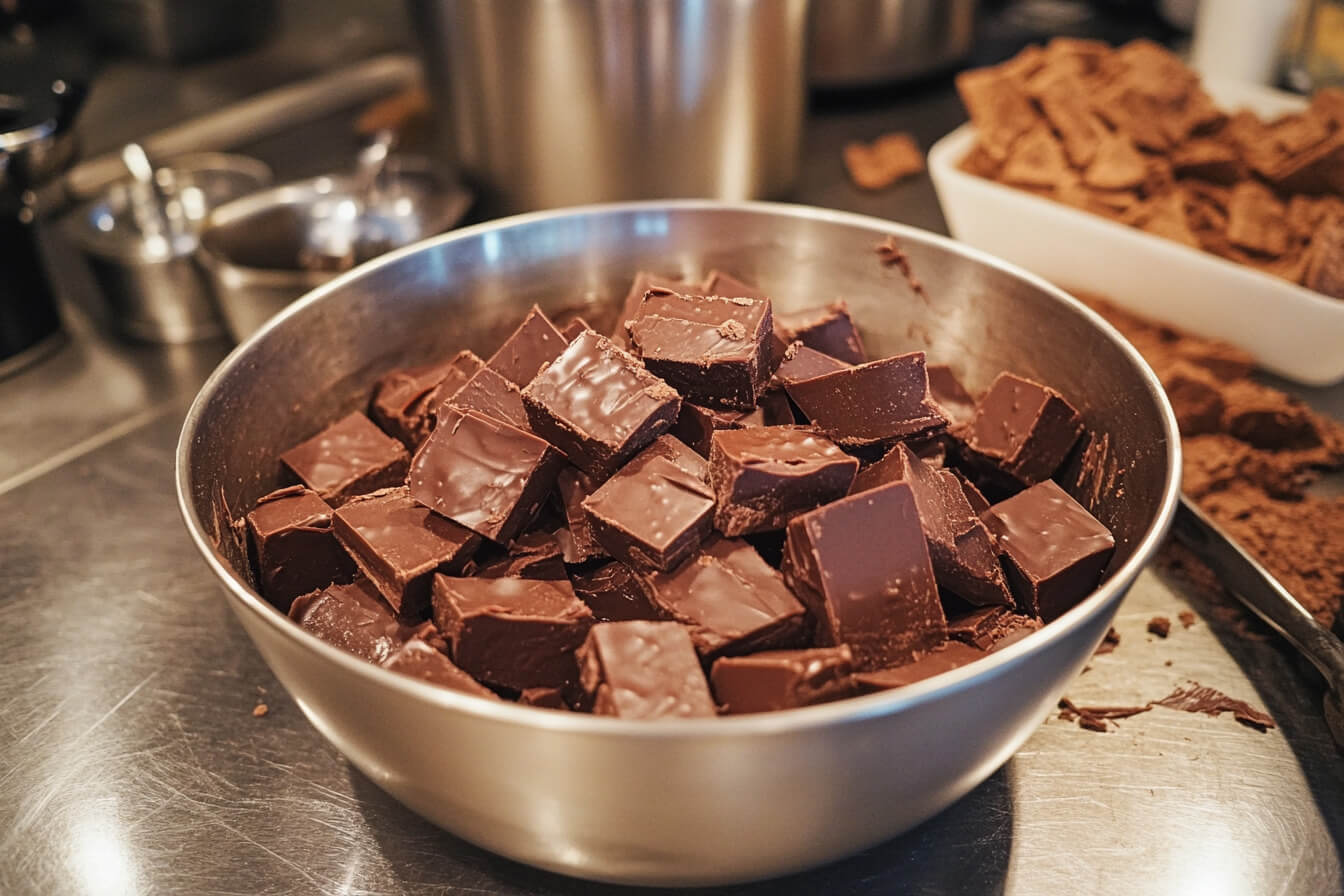Table of Contents
Introduction to Hershey Fudge
Hershey Fudge is a timeless dessert that holds a special place in the hearts of dessert lovers. Renowned for its rich, creamy texture and decadent chocolate flavor, this treat has been a household favorite for decades. Whether you’re making it for a special occasion or simply indulging in your chocolate cravings, Hershey Fudge offers a delightful experience that’s hard to resist.
A Brief History of Hershey Fudge
The origins of Hershey Fudge trace back to the early 20th century, inspired by the innovative work of Milton S. Hershey, the founder of Hershey’s Chocolate. His mission to make chocolate accessible to everyone led to the creation of versatile cocoa products that became staples in American kitchens. Home cooks began experimenting with Hershey’s cocoa powder, crafting fudge recipes that were both simple and irresistible. Over time, Hershey Fudge evolved into a cherished tradition, symbolizing comfort and nostalgia.
Why Hershey Fudge is a Classic Dessert
Hershey Fudge stands out as a classic dessert for several reasons:
- Simplicity: The recipe requires only a handful of ingredients, making it an easy dessert for beginners and seasoned bakers alike.
- Flavor: The rich, chocolatey taste is unparalleled, thanks to the use of high-quality Hershey’s cocoa.
- Versatility: Hershey Fudge can be customized with nuts, marshmallows, or even a touch of sea salt for a gourmet twist.
- Tradition: Making fudge is often a shared experience, passed down through generations and enjoyed with loved ones.
Whether you’re new to baking or a seasoned pro, Hershey Fudge is a must-try recipe that brings joy to any occasion.
Ingredients for Perfect Hershey Fudge
Creating the perfect Hershey Fudge starts with selecting the right ingredients. Each component plays a crucial role in achieving the fudge’s signature creamy texture and rich chocolate flavor. Below is a breakdown of the key ingredients and some alternatives or substitutions for flexibility.
Key Ingredients Explained
- Hershey’s Cocoa Powder
The star of the recipe, Hershey’s cocoa powder, delivers a deep and authentic chocolate flavor. Its high-quality processing ensures a smooth consistency, essential for a perfect fudge. - Granulated Sugar
Sugar is crucial for the structure and sweetness of the fudge. It caramelizes during cooking, contributing to the velvety texture that defines classic fudge. - Milk
Milk acts as the liquid base, binding the ingredients together. Whole milk is preferred for its richness, but other types of milk can work depending on dietary needs. - Butter
Butter enhances the fudge’s creaminess and adds a rich, buttery flavor that complements the chocolate perfectly. - Vanilla Extract
Vanilla extract adds depth to the flavor profile, enhancing the chocolate’s sweetness and providing a subtle aromatic note. - Salt
A pinch of salt balances the sweetness and accentuates the chocolate flavor, creating a more complex and satisfying taste.
Alternatives and Substitutions
- Cocoa Powder
If Hershey’s cocoa powder is unavailable, any high-quality unsweetened cocoa powder can be used. However, the flavor may differ slightly. - Milk Substitutes
For a dairy-free version, substitute whole milk with almond milk, coconut milk, or oat milk. Note that these alternatives may alter the fudge’s texture and flavor. - Sugar Alternatives
For a reduced-sugar option, use a sugar substitute like erythritol or stevia. Keep in mind that these may affect the consistency and require adjustments to the cooking process. - Butter Substitutes
Replace butter with margarine or coconut oil for a vegan-friendly or lactose-free alternative. Coconut oil will impart a slight coconut flavor, which can complement the chocolate. - Vanilla Variations
If vanilla extract is unavailable, try almond extract or a touch of coffee extract for a unique twist. - Add-Ins and Toppings
Personalize your fudge by mixing in chopped nuts, dried fruit, or marshmallows. For a gourmet touch, sprinkle sea salt or drizzle caramel over the top.
By carefully selecting and customizing these ingredients, you can create a Hershey Fudge that suits your taste and dietary preferences, ensuring a delicious and satisfying result every time.
Step-by-Step Guide to Making Hershey Fudge
Making Hershey Fudge at home is a rewarding experience, and with a little preparation and attention to detail, you can achieve professional-quality results. Follow this step-by-step guide to create the perfect fudge.
Preparing Your Workspace
- Gather Ingredients and Tools
Ensure all your ingredients are measured and ready to use. You’ll need:- Hershey’s cocoa powder
- Granulated sugar
- Milk
- Butter
- Vanilla extract
- Salt (optional)
Tools include a heavy-bottomed saucepan, wooden spoon, candy thermometer, and a greased or parchment-lined pan.
- Set Up Your Cooking Area
Keep your workspace clean and organized. Place all tools and ingredients within easy reach to avoid disruptions during the cooking process. - Prepare the Pan
Grease a square or rectangular pan with butter or line it with parchment paper for easy removal of the fudge once it sets.
The Cooking Process
- Combine Ingredients
In a heavy-bottomed saucepan, mix 2/3 cup of Hershey’s cocoa powder, 3 cups of granulated sugar, and a pinch of salt (optional). Stir to combine evenly. - Add Milk
Gradually pour in 1 1/2 cups of milk while stirring, ensuring the dry ingredients are fully incorporated without lumps. - Heat the Mixture
Place the saucepan over medium heat and bring the mixture to a boil, stirring constantly to prevent sticking or burning. - Cook to the Right Temperature
Once boiling, reduce the heat slightly and attach a candy thermometer to the side of the pan. Cook until the mixture reaches the soft-ball stage (234–240°F or 112–116°C). - Add Butter and Vanilla
Remove the saucepan from heat and immediately stir in 1/4 cup of butter and 1 teaspoon of vanilla extract. Avoid overmixing at this stage to maintain a smooth texture. - Cool the Mixture
Allow the mixture to cool slightly (to about 110°F or until lukewarm) before beating. - Beat the Fudge
Using a wooden spoon, beat the mixture vigorously until it thickens and loses its gloss. This step is crucial for achieving the classic fudge texture. - Pour and Set
Pour the fudge into the prepared pan and spread it evenly. Let it set at room temperature for 2–3 hours or until firm.
Tips for Perfect Consistency
- Use a Candy Thermometer
Precision is key. A candy thermometer ensures you reach the exact temperature needed for the soft-ball stage. - Stir Consistently
Constant stirring prevents scorching and ensures an even texture. - Monitor Cooling Time
Do not rush the cooling process before beating the fudge. Beating too soon can result in a grainy texture. - Work Quickly but Carefully
Once the fudge thickens, pour it into the pan quickly as it will start to set fast. - Store Properly
After cutting the fudge into squares, store it in an airtight container to maintain its freshness and texture.
By following these steps and tips, you’ll be able to create a smooth, creamy, and irresistibly delicious Hershey Fudge that’s perfect for sharing—or keeping all to yourself!

Common Problems and Their Solutions
Even with careful preparation, making Hershey Fudge can sometimes result in unexpected challenges. Here’s a guide to troubleshooting common issues to ensure your fudge turns out perfectly every time.
Why is My Fudge Grainy?
A grainy texture is one of the most common fudge issues and is usually caused by sugar crystals forming during the cooking or cooling process.
Possible Causes:
- Stirring the mixture after it starts boiling.
- Failing to dissolve all the sugar before boiling.
- Not cooking the fudge to the correct temperature.
Solutions:
- Dissolve Sugar Thoroughly: Before heating, stir the mixture well to ensure all sugar granules are dissolved.
- Avoid Stirring After Boiling: Once the mixture begins to boil, do not stir. Let it cook undisturbed to prevent sugar crystals from forming.
- Use a Candy Thermometer: Ensure you reach the soft-ball stage (234–240°F or 112–116°C) for the right consistency.
How to Fix Fudge That Won’t Set
If your fudge remains runny or doesn’t firm up, it may not have been cooked long enough or to the proper temperature.
Possible Causes:
- Undercooking the mixture.
- Insufficient beating after cooling.
Solutions:
- Re-Cook the Fudge: Pour the mixture back into the saucepan, add a small amount of milk, and reheat it. Cook to the soft-ball stage and repeat the cooling and beating steps.
- Check Temperature Carefully: Use a candy thermometer to ensure you’re reaching the correct temperature during cooking.
- Allow Time to Set: Let the fudge sit at room temperature for at least 2–3 hours to firm up completely.
What to Do If Your Fudge Is Too Soft
Soft fudge that doesn’t hold its shape could be the result of too much moisture or insufficient cooling time.
Possible Causes:
- Using too much milk or butter.
- Cutting the fudge before it’s fully set.
Solutions:
- Refrigerate the Fudge: Place the fudge in the refrigerator for an hour or two to help it firm up. Avoid freezing, as this can alter the texture.
- Re-Cook with Adjustments: Reheat the fudge, adding a small amount of sugar to help thicken it. Cook to the correct temperature and follow the cooling process again.
- Store in Cooler Conditions: Soft fudge can sometimes result from a warm environment. Keep it in a cool, dry place.
Creative Variations of Hershey Fudge
Hershey Fudge is a versatile dessert that can be customized to suit your taste. From mix-ins to unique shapes, here are some creative variations to make your fudge extra special.
Adding Nuts, Fruits, and Other Mix-Ins
- Nuts: Add chopped walnuts, pecans, or almonds for a crunchy texture that complements the smooth fudge.
- Dried Fruits: Mix in raisins, dried cranberries, or chopped apricots for a sweet and tangy twist.
- Candy and Cookies: Incorporate crushed peppermint candies, mini marshmallows, or crumbled cookies for a fun and flavorful touch.
- Savory Additions: Sprinkle a pinch of sea salt or add a dash of cayenne pepper for a unique flavor contrast.
Chocolate Flavor Enhancements
- Layered Fudge: Create layers by dividing the fudge mixture and adding white chocolate or peanut butter to one portion before layering.
- Infused Flavors: Stir in espresso powder, mint extract, or orange zest to infuse your fudge with additional flavors.
- Toppings: Drizzle melted caramel, sprinkle cocoa nibs, or add a dusting of powdered sugar for a gourmet finish.
Fun Shapes and Presentations
- Cookie Cutters: Pour the fudge onto a flat surface and use cookie cutters to create festive shapes for holidays or special occasions.
- Molded Fudge: Use silicone molds in fun shapes like hearts, stars, or animals to make individually portioned fudge pieces.
- Layered and Swirled Designs: Swirl in contrasting chocolate or peanut butter mixtures for a marbled effect.
- Gift Presentation: Wrap fudge squares in wax paper or place them in decorative tins to give as thoughtful gifts.
These creative variations allow you to customize your Hershey Fudge to fit any occasion, making it a delightful and memorable treat for everyone.
Storing and Serving Your Hershey Fudge
Proper storage and thoughtful presentation enhance the enjoyment of your Hershey Fudge, whether you’re saving it for later or serving it at an event.
Best Practices for Storing Fudge
- Room Temperature Storage:
- Store fudge in an airtight container at room temperature for up to 1–2 weeks.
- Keep it in a cool, dry place away from heat or sunlight.
- Refrigeration:
- If you prefer firmer fudge or live in a warm climate, refrigerate it. Wrap each piece in wax paper or plastic wrap to prevent it from drying out or absorbing odors.
- Freezing:
- For long-term storage, freeze fudge by wrapping it tightly in plastic wrap and placing it in an airtight container.
- Fudge can be frozen for up to 3 months. Thaw it at room temperature before serving to preserve its texture.
- Avoid Moisture Exposure:
- Keep the fudge away from humidity, as moisture can alter its texture and lead to stickiness.
Serving Suggestions for Special Occasions
- Elegant Platters:
- Arrange fudge squares on a decorative platter, garnished with sprigs of mint or dusted with cocoa powder for a sophisticated presentation.
- Layered Desserts:
- Use fudge pieces as layers in parfaits or trifles, combining them with whipped cream, berries, and other desserts.
- Holiday Themes:
- Cut fudge into shapes using cookie cutters, such as stars for Independence Day or trees for Christmas.
- Gift Boxes:
- Place fudge pieces in festive tins or decorative boxes with tissue paper for thoughtful and delicious gifts.
- Pairings:
- Serve fudge with coffee, hot chocolate, or wine for an indulgent pairing experience.
Nutritional Information and Health Tips
Understanding the nutritional profile of Hershey Fudge can help you enjoy it responsibly while exploring ways to make it healthier.
Calorie Breakdown of Hershey Fudge
Here’s an approximate nutritional breakdown per square (1-inch piece) of Hershey Fudge:
- Calories: 120–150
- Total Fat: 5–7 g
- Saturated Fat: 3–4 g
- Carbohydrates: 18–22 g
- Sugar: 15–18 g
- Protein: 1–2 g
(Note: These values may vary based on the specific recipe and serving size.)
Healthier Alternatives and Modifications
- Reduce Sugar:
- Use natural sweeteners like honey or stevia in place of some or all of the granulated sugar to reduce calorie content.
- Lower Fat Options:
- Substitute full-fat milk with skim milk or plant-based milk for a lighter version.
- Replace butter with a healthier fat, such as avocado oil or coconut oil.
- Incorporate Superfoods:
- Add nutrient-rich ingredients like chia seeds, flaxseeds, or dark chocolate for added health benefits.
- Portion Control:
- Cut fudge into smaller pieces to reduce the calorie intake per serving.
- Dairy-Free or Vegan Options:
- Use almond milk, coconut milk, or oat milk along with dairy-free butter alternatives to make the recipe vegan-friendly.
By storing and serving fudge thoughtfully and exploring healthier recipe modifications, you can enjoy the indulgence of Hershey Fudge while aligning with your nutritional goals and delighting your guests.
Explore more Idea:
Fudge Recipes: Simple and Delicious Fudge Recipes for Beginners.
Oreo Fudge: How to Make Perfect Oreo Fudge: Easy Recipe and Tips.

Frequently Asked Questions About Hershey Fudge
What is the secret to perfect fudge?
The key to perfect fudge lies in precision and patience. Here are the main factors:
- Temperature: Cook the fudge to the soft-ball stage (234–240°F) using a candy thermometer for accuracy.
- Cooling Time: Allow the fudge to cool to about 110°F before beating to ensure proper crystallization.
- Beating Technique: Beat the fudge until it thickens and loses its gloss, but stop before it becomes too stiff.
- Quality Ingredients: Use high-quality cocoa powder, fresh milk, and butter to achieve the best flavor and texture.
Is it better to use condensed milk or evaporated milk for fudge?
Both condensed milk and evaporated milk can be used for fudge, but they serve different purposes:
- Condensed Milk: Sweetened condensed milk adds sweetness and creaminess, eliminating the need for additional sugar. It’s great for quick, no-cook fudge recipes.
- Evaporated Milk: Unsweetened evaporated milk is ideal for traditional fudge recipes where sugar is cooked to the soft-ball stage. It allows for more control over the fudge’s sweetness and consistency.
Choose based on the recipe and your desired flavor profile.
Why is my Hershey’s fudge not setting?
If your fudge isn’t setting, it’s likely due to one of these reasons:
- Undercooking: The mixture may not have reached the soft-ball stage (234–240°F).
- Too Much Liquid: Adding extra milk or butter can prevent the fudge from firming up.
- Improper Cooling: Beating the fudge before it cools sufficiently can affect its ability to set.
Solution: Reheat the fudge, cook it to the correct temperature, and allow it to cool properly before beating.
What is the secret to smooth fudge that is not gritty?
Gritty fudge is caused by sugar crystals forming during the cooking process. To ensure smooth fudge:
- Dissolve the Sugar Completely: Stir the sugar mixture thoroughly over low heat before bringing it to a boil.
- Avoid Crystals: Wash down the sides of the saucepan with a wet pastry brush to remove stray sugar crystals.
- Cool Without Disturbance: Let the fudge cool undisturbed to avoid introducing new crystals.
- Use a Candy Thermometer: This ensures precise cooking to the soft-ball stage for proper crystallization.
By paying attention to these details, you can achieve fudge that is rich, creamy, and free of grittiness.
Conclusion
Hershey Fudge is a classic dessert that combines simplicity, versatility, and irresistible flavor. Whether you’re crafting the traditional recipe, exploring creative variations, or troubleshooting common issues, this timeless treat is sure to delight both novice and experienced bakers. By following the tips and techniques outlined, you can create smooth, creamy fudge that’s perfect for any occasion, from everyday indulgence to festive celebrations. With proper storage and thoughtful presentation, Hershey Fudge becomes a memorable and cherished addition to your dessert repertoire. Enjoy the sweet success!

